Abstract
The Bozhushan in southeastern Yunnan is a composite granite body that was formed by multi-phase magmatic intrusion. The genesis of the tourmaline-supergroup minerals occurring therein remains uncertain, as it has been the subject of only a limited number of studies. This investigation employs an integrated analytical approach combining EPMA, LA-ICP-MS, and boron isotope geochemistry, supplemented by detailed field geological investigations and petrographic observations of tourmaline textural characteristics. This study aims to elucidate the genetic relationships between distinct tourmaline varieties, establish temporal correlations between mineral crystallization stages and magmatic–hydrothermal evolution processes, and evaluate the petrogenetic significance of tourmaline geochemical signatures for regional mineralization events. This study analyzes tourmaline-supergroup minerals in granitic pegmatites and aplites, which occur as nodular, radial, and columnar aggregates. Most tourmaline crystals exhibit well-defined rhythmic zoning patterns, which are clearly observable under cross-polarized light microscopy. Chemical composition analysis has identified two tourmaline species: schorl and dravite. The formation of tourmaline is primarily of magmatic origin and is characterized by a magmatic–hydrothermal transition. It predominantly belongs to the alkali subgroup and is formed in Li-poor granitoids and associated pegmatites and aplites, Ca-poor metapelites, metapsammites, and quartz-tourmaline rocks. The inter-ionic substitution mechanism in this system is predominantly governed by Fe2+Mg−1 and (XvacAl)(NaR2+)−1 exchange equilibria. Additionally, geochemical evidence indicates that the primary ore-forming fluids originate from granitic magmas, which are likely sourced from the partial melting of metasedimentary rocks. During the late Yanshan period, the upwelling of granitic magma in the Bozhushan area introduced a substantial heat source and mineralizing fluids, which interacted with the Cambrian units to form tungsten–tin mineralization. The geochemical data on tourmaline indicate that the Bozhushan granite body has considerable potential for ore mineralization.
1. Introduction
The southeastern region of Yunnan, China, is the area where three major granite rock formations have originated: Gejiu, Bozhushan, and Laojunshan. This region’s geological features represent a substantial mineral resource, which has been a significant contributing factor in the advancement of its economic and industrial development. The Bozhushan granite body is located at the confluence of the Mengzi and Wenshan rivers in the southeastern region of Yunnan Province. It is situated within the Southeast Yunnan Fold Belt, which represents a segment of the Cathaysia Fold System. The Honghe Fracture Zone is situated to the west of the Bozhushan granite body (Figure 1). In the late stage of magmatism, magmatic–hydrothermal fluids are supposed to be responsible for the formation of skarn-type tungsten–tin polymetallic deposits, which are characterized by mineralogy predominantly comprising tin, tungsten, lead, and zinc. The deposits are concentrated in the Bainiuchang mine area and in the vicinity of the Bozhushan granite body [1,2,3]. Previous research indicated that a significant magmatic event occurred during the Late Cretaceous Period in western South China. This provides further evidence to support the hypothesis that the Bozhushan region is an area of significant magmatic interest [4].
Tourmaline is the generic term for a group of minerals collectively termed the “tourmaline-supergroup” [5,6,7]. Tourmaline is the most significant borosilicate mineral, which occurs in varied geological environments and provides a significant insight into the petrology of individual geological environments. The most common species of tourmaline-supergroup minerals are dravite, schorl, and elbaite [8,9]. Tourmaline is a cyclosilicate mineral widely distributed in crustal lithologies and is considered to be a sensitive petrogenetic indicator due to its wide range of P-T stability and compositional variability, which is fundamentally constrained by ambient geochemistry. This mineral phase displays exceptional resilience to physicochemical deviations and preserves diagnostic signatures through geological timescales despite fluctuations in P-T conditions, metasomatic fluid activities, and protolith heterogeneity [10]. Tourmaline often features dual-phase crystallization behavior: the primary nucleation phase occurs during magmatic crystallization, and the late-stage mineral phase occurs during the transition from sub-solidus to hydrothermal conditions. These extended crystallization conditions, including processes from residual melt percolation to hydrothermal overprinting events, make tourmaline primarily a diagnostic mineral for reconstructing the trajectories of fluid–melt evolution within evolving magmatic systems [11]. Tourmaline is typically formed in granite and pegmatite with elevated acidity [12].
Tourmaline has been identified as a valuable recorder of magmatic evolution and an indicator of tin–tungsten mineralization [13]. The periphery of the granite body of Bozhushan features a combination of multiple types of mineral deposits, including tungsten deposits of the rock body of Yanyangpo, tungsten deposits of the Yaodian-Guanfang-Erhegou diorite, tin–polymetallic deposits of Dongualing, tungsten deposits of the Laojunshan contact-accountable type, lead–zinc deposits of the Suozuodi diorite, and silver deposits of Xiachang sedimentary rock. Previous studies have systematically described the time frame and genesis model of the metallogenic system in this area; however, the mineralogical study of the genesis of tourmaline in granite is still insufficient, e.g., key scientific issues such as the significance of its chemical characteristics during the magmatic–hydrothermal evolution stage, and the relationship between the mechanism of ore-forming fluid transport and sedimentation. These unanswered scientific inquiries prevent the precise understanding of the material–energy transport process within this composite metallogenic system [3].
The presented study employs tourmaline from Bozhushan as its main research object. Through field geological investigations and sampling, and on the basis of the macroscopic and microscopic structural characteristics of tourmaline-supergroup minerals, we use a range of analytical techniques, including EPMA, LA-ICP-MS, and boron isotope analysis, to examine the genesis of tourmaline, the relationship between magmatic–hydrothermal evolution, and the significance of mineralization.
2. Geological Setting
The Bozhushan is situated approximately 30 km west of Wenshan County, extending northwesterly in a lenticular shape, with an exposed area of approximately 120 km2. It is situated on the northwestern flank of the Bozhushan arch fold, which is a part of the Wenshan-Funing fault bundle within the Southeast Yunnan fold system. The northwestern part of the Pingma paleocontinent is situated in a geotectonic position, adjacent to the Honghe fault zone to the west and the Gejiu fault bundle to the north. The tectonic deformation in this area is primarily evidenced by the extensive and gradual isoclinal folds at the shallow surface level, as well as the brittle fractures that have formed during various geological events. The main tectonic lines in this region are in a north-east orientation, followed by a north-west orientation [4,14,15,16]. The granite body was formed at the intersection of a north-east-oriented anticline and a north-west-oriented fault. The later magma intrusion occurred along the north-west-oriented tensional faults, resulting in the formation of a nose-like structure in the north-west corner of the granite body and, moreover, a series of positive faults formed at the periphery of the granitic body. A variety of contact metamorphic processes are evident in the contact zone at the periphery of the rock body, including silicification and the presence of hornblende and metagabbro [4,14,15,16,17]. The stratigraphic sequence of the Bozhushan region includes the Upper Cambrian, Lower Ordovician, Devonian, and Quaternary units. The Cambrian unit is primarily composed of the Chongzhuang Formation, Dazhai Formation, Dayakou Formation, Tianpong Formation, and Longha Formation, among others. The Ordovician unit is predominantly represented by the Xiamududi Formation, Dushuke Formation, Laozhai Formation, and so forth. The Devonian unit is largely represented by the Posongchong and Pojiao Formations. The Cambrian and Ordovician units are primarily distributed in the southern and eastern regions of the granite body. The deposits from the Bozhushan are primarily sourced from the siltstone–limestone–dolomite unit of the Middle Cambrian Tianpeng Formation and Longha Formation, as well as from the limestone of the Dayakou Formation and its associated granite body in the contact rocks [3,18].
The acidic rocks exposed in this area are mainly grayish-white, light flesh-red, biotite-bearing adamellite, with an obvious porphyritic structure, massive structure, and medium-grained hypidiomorphic texture in the matrix. The essential minerals include plagioclase feldspar, potassium feldspar, quartz, and biotite, and the accessory minerals mainly include zircon, apatite, etc. During the Late Yanshan Period, the intrusion of acidic magma under the influence of tectonic activity led to the formation of the Bozhushan composite granite body. The magma intruded into the Lower Paleozoic Cambrian and Ordovician units, resulting in the development of a series of extensional slip tectonics around the granite body. The formation of the Bozhushan dome is attributed to the top-supporting effect of the upward movement of the granitic magma, which provides an important channel and space for the transport and precipitation of mineral-bearing magmatic–hydrothermal fluids. During magmatic differentiation, tungsten, tin, and other mineralizing elements are separated from the magma melt and enrich the hydrothermal fluids, which later form ore minerals. The deposits in the Bozhushan area can be classified into three categories based on the distance of the ore body from the granitic body. The first category comprises high-temperature skarn-type tungsten deposits, presented by the Guanfang and Erhegou tungsten mines. The second category includes medium-temperature hydrothermal vein-type silver polymetallic deposits, presented by Bainiuchang silver–lead–zinc polymetallic deposits. The third category comprises low-temperature hydrothermal vein-type antimony deposits, presented by the Maoshandong antimony mine [1,2,3,16,19].
The magmatism in this region can be divided into two different phases: a Late Permian continental rift-type basal magmatic intrusion and ejecta and a large-scale acidic magmatic intrusion of a Cretaceous age [18]. The Bozhushan granite body was formed by the intrusion of two phases of granitic magma during the Yanshan Period. The first phase was dominated by medium-grained biotite monzogranite, while the second phase was dominated by fine-grained monzogranite. Furthermore, both phases evinced an intrusive contact relationship [4,17]. Previous researchers divided the rock body into seven units, two sequences, and one independent unit. For the purpose of this study, only units related to the occurrence of tourmaline in Bozhushan granite are mentioned further (Figure 1D) [2]. The lithology of each unit is delineated in Table S1.
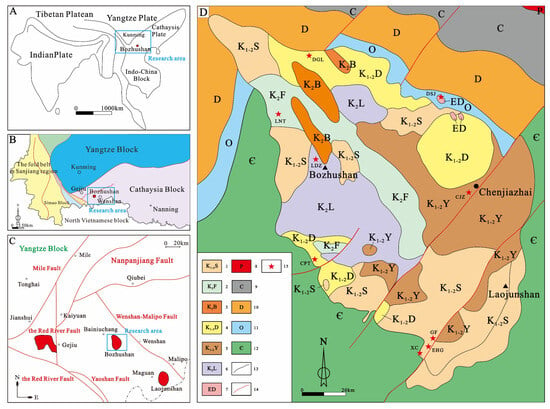
Figure 1.
The tectonic setting of the research area and the geological map of the Bozhushan [1,2,3,19]. (A–C): Geotectonic and regional location maps; (D): 1—Suozuodi unit; 2—Fenshuiling unit; 3—Bozhupo unit; 4—Dashan unit; 5—Yangyushu unit; 6—Leidazhan unit; 7—Dashanjiao unit; 8—Permian; 9—Carboniferous; 10—Devonian; 11—Ordovician; 12—Cambrian; 13—Geological boundary; 14—Fault; 15—Sampling site.
3. Sampling and Petrographic Description
Granitic pegmatites and aplites are typically regarded as the result of post-magmatic processes [20,21,22]. The granitic pegmatites in the Bozhushan area are primarily characterized by a grayish-white color and a typical pegmatite structure. The pegmatites exhibit a diverse texture, including vein-like and massive forms, and are composed of large crystal grains. The dominant mineralogical composition of these pegmatites is quartz, feldspar, and mica; other minerals include tourmaline, chalcopyrite, pyrite, and pyrrhotite. The granitic aplite is primarily characterized by a grayish-white color and a distinctive fine-grained structure, exhibiting a sugar-like texture. These rocks are predominantly composed of feldspar and quartz. The granitic pegmatites and aplites in the Bozhushan intruded into the granite body and the surrounding rocks. Previous studies have found that vein activity was simultaneous with the granite body activity [14,15]. Therefore, on the basis of the classification of the granite bodies in the Bozhushan, the Chenjiazhai sequence (Suozuodi unit, Yangyushu unit, and Dashan unit), the Bozhushan sequence (Bozhupo unit, Leidazhan unit, and Fenshuiling unit) and the Dashanjiao independent unit were selected for the sampling in this study [2]. The combination of field exploration and in-lab petrographic description led to the classification of two types of tourmaline, which were named after the sampling sites (Chenjiazhai—CJZ, Lannitang—LNT, Leidazhan—LDZ, Xiachang—XC, Changputang—CPT, Donggualin—DGL, Erhegou—EHG, Dashanjiao—DSJ, Guanfang—GF). The following sample numbers and characteristics are provided for each type:
3.1. Tourmaline in Pegmatite
- Chenjiazhai tourmaline (CJZ-TUR): This sample was obtained from the Yangyushu unit and represents grayish-white tourmaline-bearing granitic pegmatite. Tourmaline is black and forms radial aggregates. Under the microscope, tourmaline forms euhedral-to-subhedral grains and radial aggregates. In single-polarized light, the mineral has a yellowish-brown color when observed parallel to the c-axis. In contrast, perpendicular to the c-axis, it shows alternating bluish-green and yellowish-green interference colors. Additionally, the sample has a distinct basal rhyolitic ring texture (Figure 2A,D,G).
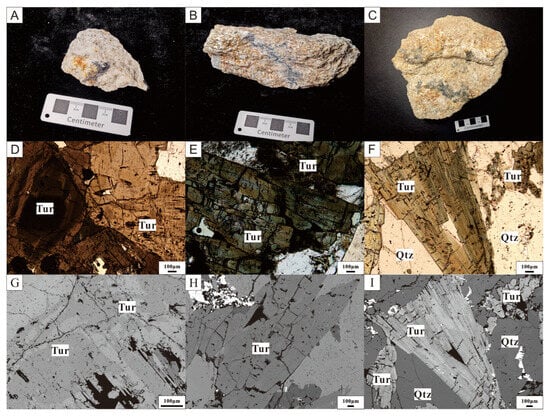 Figure 2. Photos of radial tourmaline in granite pegmatites in the Bozhushan area. (A,D,G): Grayish-white tourmaline-bearing granitic pegmatite: the tourmaline forms euhedral-to-subhedral grains and radial aggregates; it has a yellowish-brown color in single-polarized light (CJZ-TUR). (B,E,H): Grayish-white tourmaline-bearing granitic pegmatite: the tourmaline forms euhedral-to-subhedral grains and radial aggregates; it has a pale yellow color in single-polarized light (LNT-TUR). (C,F,I): Grayish-white tourmaline-bearing granitic pegmatite: the tourmaline forms radial aggregates; it has a yellowish color in single-polarized light (LDZ-TUR). Tur—tourmaline; Qtz—quartz.
Figure 2. Photos of radial tourmaline in granite pegmatites in the Bozhushan area. (A,D,G): Grayish-white tourmaline-bearing granitic pegmatite: the tourmaline forms euhedral-to-subhedral grains and radial aggregates; it has a yellowish-brown color in single-polarized light (CJZ-TUR). (B,E,H): Grayish-white tourmaline-bearing granitic pegmatite: the tourmaline forms euhedral-to-subhedral grains and radial aggregates; it has a pale yellow color in single-polarized light (LNT-TUR). (C,F,I): Grayish-white tourmaline-bearing granitic pegmatite: the tourmaline forms radial aggregates; it has a yellowish color in single-polarized light (LDZ-TUR). Tur—tourmaline; Qtz—quartz. - Lannitang tourmaline (LNT-TUR): This sample was obtained from the Fenshuiling unit and represents grayish-white tourmaline-bearing granitic pegmatite. Tourmaline is dark brown when in the rock and forms radial aggregates. Under a microscope, tourmaline occurs as euhedral-to-subhedral grains and well-developed radial aggregates. In single-polarized light, it has a pale-yellow color. When oriented parallel to the c-axis, the mineral retains its pale-yellow coloration, whereas perpendicular to the c-axis, it has alternating yellowish-green and bluish-green interference colors (Figure 2B,E,H).
- Leidazhan tourmaline (LDZ-TUR): This sample is a grayish-white tourmaline-bearing granitic pegmatite from the Leidazhan unit. Tourmaline is dark brown and forms radial aggregates. Under a microscope, tourmaline occurs as radial aggregates with euhedral-to-subhedral crystal habits. In single-polarized light, it has a uniform pale-yellow color. When oriented parallel to the c-axis, the mineral retains this yellowish color; however, when perpendicular to the c-axis, it has alternating yellowish-green and bluish-green interference colors in cross-polarized light (Figure 2C,F,I).
- Xiachang tourmaline (XC-TUR): This sample is a grayish-white tourmaline-bearing granitic pegmatite from the Suozuodi unit. Tourmaline is black and forms nodular aggregates. In single-polarized light, tourmaline forms granular aggregates, which have a yellowish-brown color when oriented parallel to the c-axis and a dark-brown color when perpendicular to the c-axis. The aggregates have blue rims and partially visible rhyolitic ring bands. Additionally, the ore body has a stellate distribution and is characterized by the presence of pyrite and chalcopyrite (Figure 3A,D,G).
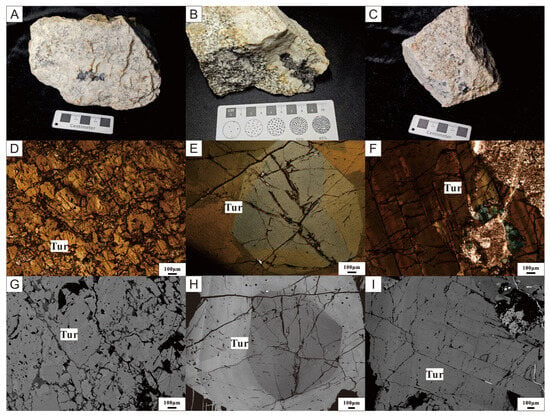 Figure 3. Photos of nodular tourmaline in granite pegmatites in the Bozhushan area. (A,D,G): Greyish-white tourmaline-bearing granitic pegmatite, in single-polarized light; the tourmaline forms yellowish-brown granular aggregates (XC-TUR). (B,E,H): Grayish-white tourmaline-bearing granitic pegmatite: the tourmaline has a yellowish-green color in single-polarized light, a yellowish-green color in orthogonally polarized light, a developed ring band, and a sub-hexagonal nucleus (CPT-TUR). (C,F,I): Grayish-white tourmaline-bearing granitic pegmatite, in single-polarized light: the tourmaline appears in yellowish-brown color (DGL-TUR). Tur—tourmaline.
Figure 3. Photos of nodular tourmaline in granite pegmatites in the Bozhushan area. (A,D,G): Greyish-white tourmaline-bearing granitic pegmatite, in single-polarized light; the tourmaline forms yellowish-brown granular aggregates (XC-TUR). (B,E,H): Grayish-white tourmaline-bearing granitic pegmatite: the tourmaline has a yellowish-green color in single-polarized light, a yellowish-green color in orthogonally polarized light, a developed ring band, and a sub-hexagonal nucleus (CPT-TUR). (C,F,I): Grayish-white tourmaline-bearing granitic pegmatite, in single-polarized light: the tourmaline appears in yellowish-brown color (DGL-TUR). Tur—tourmaline. - Changputang tourmaline (CPT-TUR): This sample is a grayish-white tourmaline-bearing granitic pegmatite from the Dashan unit. Tourmaline is black and forms nodular aggregates. In single-polarized light, tourmaline has a yellowish-green color. In cross-polarized light, it has alternating yellowish-green interference colors, accompanied by a well-developed concentric zoning pattern and a subhedral hexagonal core. Additionally, blue tourmaline is observed in the peripheral margins, with occasional star-shaped pyrite (Figure 3B,E,H).
- Donggualin tourmaline (DGL-TUR): This sample is a grayish-white tourmaline-bearing granitic pegmatite from the Dashan unit. Tourmaline is black and forms nodular aggregates. When observed in single-polarized light, tourmaline has a yellowish-brown color. When observed parallel to the c-axis, tourmaline has a light blue color. However, when viewed perpendicularly to the c-axis, it has a yellowish-brown and yellowish-green color, with bluish-green tourmaline visible around its periphery. Furthermore, a rhyolite annular zone is discernible, and no mineralization is seen (Figure 3C,F,I).
- Erhegou tourmaline (EHG-TUR): This sample is a grayish-white tourmaline-bearing granitic pegmatite from the Suozuodi unit. The tourmaline is black, and a column-shaped core can be observed. Scheelite is present on the surface of tourmaline crystals. The cross-section of the tourmaline crystal resembles a spherical triangle. In single-polarized light, parallel to the c-axis, it has a yellowish-brown color, and perpendicular to the c-axis, it has a yellowish color. When observed in orthogonally polarized light, the color is yellow, and in blue light, the color is blue-green. Pyrite occurs occasionally and forms star-shaped crystals and grains (Figure 4).
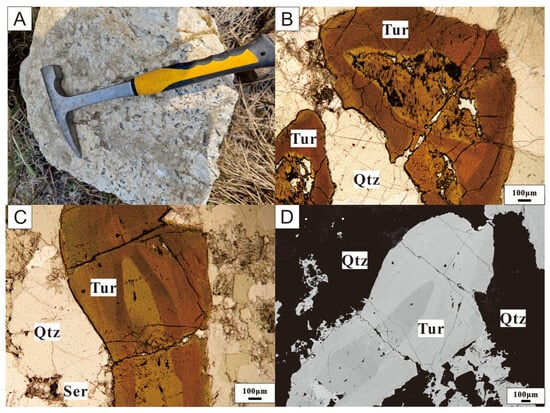 Figure 4. Photos of columnar tourmaline in granite pegmatites. (A–D): Grayish-white tourmaline-bearing granitic pegmatite: in single-polarized light, the color is yellowish-brown, and a column-shaped core can be observed (EHG-TUR). Tur—tourmaline; Qtz—quartz; Ser—sericite.
Figure 4. Photos of columnar tourmaline in granite pegmatites. (A–D): Grayish-white tourmaline-bearing granitic pegmatite: in single-polarized light, the color is yellowish-brown, and a column-shaped core can be observed (EHG-TUR). Tur—tourmaline; Qtz—quartz; Ser—sericite.
3.2. Tourmaline in Aplite
- Dashanjiao tourmaline (DSJ-TUR): This sample is a grayish-white tourmaline-bearing granitic aplite from the Dashanjiao unit. Tourmaline is black and forms nodular aggregates. In single-polarized light, tourmaline is yellowish-brown, and a part of the cross-section resembles a hexagonal shape (Figure 5A,C,E).
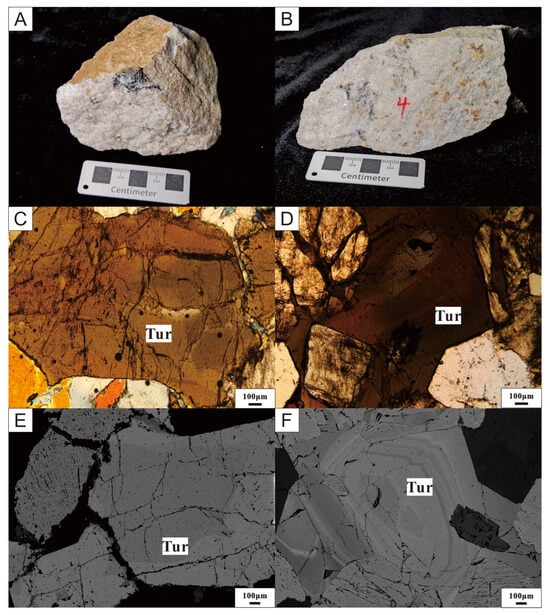 Figure 5. Photos of nodular tourmaline in granite aplites in the Bozhushan area. (A,C,E): Grayish-white tourmaline-bearing granitic aplite in single-polarized light; the tourmaline is yellowish-brown (DSJ-TUR); (B,D,F): Grayish-white tourmaline-bearing granitic aplite; the tourmaline has a cross-section resembling a spherical triangular shape (GF-TUR). Tur—tourmaline.
Figure 5. Photos of nodular tourmaline in granite aplites in the Bozhushan area. (A,C,E): Grayish-white tourmaline-bearing granitic aplite in single-polarized light; the tourmaline is yellowish-brown (DSJ-TUR); (B,D,F): Grayish-white tourmaline-bearing granitic aplite; the tourmaline has a cross-section resembling a spherical triangular shape (GF-TUR). Tur—tourmaline. - Guanfang tourmaline (GF-TUR): This sample is a grayish-white tourmaline-bearing granitic aplite from the Suozuodi unit. Tourmaline is black and forms nodular aggregates. The tourmaline cross-section is similar to a spherical triangular shape. In single-polarized light, it has a yellowish-brown color; parallel to the c-axis, it has a yellowish-green coloration; and perpendicular to the c-axis, the mineral has a bluish-green and black color. On the other hand, the tourmaline margins have a yellowish-green, blue-green, and black coloration (Figure 5B,D,F).
4. Methods
4.1. EPMA
The Electron Probe Microanalysis (EPMA) analysis of tourmaline was performed at the Shandong Analysis Center of China Metallurgical Geology Bureau, where nine samples in total were tested. In order to systematically analyze the spatial distribution, heterogeneity, and compositional heterogeneity of tourmaline within the same sample, the presented study adopted a metallogenetic mineralogical microdonation analysis strategy. The strategy involves selecting two representative samples of tourmaline for each of the sampling sites. These samples are then microstructurally characterized. Based on this characterization, 10 points are systematically laid out along the core-edge profile and lattice dominant growth surface of a single mineral sample. The experimental instrument, a JEOL (Japan Electronics, Tokyo, Japan) JXA-8230 electron microprobe microanalyzer, was used for the analyses. The analytical conditions were as follows: working voltage, 15 kV; beam current, 2×10⁻⁸ nA; and analytical beam spot size 10 μm. All data were corrected using the ZAF method (the ZAF correction means a correction that has the following three effects on the characteristic X-ray intensity when performing quantitative analysis: (1) the atomic number (Z) effect, (2) absorption (A) effect, and (3) fluorescence excitation (F) effect. Major elements (content greater than 1%) were corrected by a peak integration time of 10–20 s and a background integration time of 5–10 s. Trace elements (content less than 1%) were corrected by a peak integration time of 20–40 s and a background integration time of 10–20 s. As the standard samples, American SPI mineral/metal standards and Chinese national standard samples GSB were used.
4.2. LA-ICP-MS
The Laser Ablation–Inductively Coupled Plasma–Mass Spectrometer (LA-ICP-MS) analysis of tourmaline was performed at the Shandong Analysis Center of China Metallurgical Geology Bureau. Nine samples in total were tested, with ten points selected for the analysis for each sample. The LA-ICP-MS laser ablation system is a GeoLasPro 193 nm ArF excimer system produced by Coherent, USA, and the ICP-MS is a Thermo Fisher ICAP Q. The conditions of LA-ICP-MS were as follows: a beam spot diameter of 20/30/40 μm, a repetition rate of 5 Hz, and a laser fluence of about 10–12 J/cm2, the LA-ICP-MS parameters were optimized based on the standard reference material (SRM) NIST 610. The single-point analyses of NIST SRM 610 under laser ablation conditions (with an energy density of approximately 10–12 J/cm2) produced the following results: 238U sensitivity greater than 4 × 105 cps/ppm; 208Pb sensitivity greater than 3 × 105 cps/ppm; ThO/Th less than 0.1%; 204Pb gas blank of less than 100 cps; and a relative standard deviation (RSD) for the majority of elements (REE, U, Th, and Pb) less than 3%. The unknown samples were tested with NIST SRM 610, 612, BCR-2G, BIR-1G as external standards and CGSG-1 and CGSG-2 as monitor samples. The measurement was performed in a peak-hopping mode, with 25 s of the background acquisition (gas blank), 60 s of ablation time from a single point, and 25 s of aerosol washout. A set of compositional standards (NISTs 610) was inserted into every 5–10 unknown sample points. The elemental composition of the samples was processed using the ICPMSDATACAL program (Version 10.7), with the normalization method (Si) employed to correct any discrepancies.
4.3. Major- and Trace-Element Analysis of Whole Rock
The whole-rock major and trace element analysis was conducted at the Cores and Samples Center of Land and Resources (CGS), where eight samples in total were tested. Each sample represented a distinct granite unit. The main analytical methods are as follows: The first method was annealing, which involved placing the sample in a muffle furnace and heating it to a temperature of 1000 °C ± 25 °C for two hours. After this, the sample was removed from the furnace and left to cool slightly. The weight of the sample was then measured, and the loss of the weight due to volatilization was calculated. The result was expressed as a percentage of the initial weight of the sample. The second method was the use of lithium tetraborate: the lithium metaborate solvent, ammonium nitrate as an oxidizing agent, and a small amount of ammonium bromide as a release agent. The testing material and the sample were combined in a 1:10 ratio and melted in the muffle furnace at 1150 °C. Glass samples were prepared for X-ray fluorescence spectroscopy to determine the intensity of fluorescence, which was then used to calculate the amount of primary and secondary components. Thirdly, trace rare earths were dissolved with hydrofluoric acid and nitric acid in a closed dissolving apparatus. The electric hot plate was used to evaporate the hydrofluoric acid, and the solution was then sealed with aqua regia to dissolve it. The diluted solution was measured using inductively coupled plasma spectrometry (ICP) and inductively coupled plasma spectrometry (ICP-MS) with an external standard method, which was used to determine the content of trace and rare earth elements. Arsenic, antimony, and mercury were analyzed separately. After the experimental samples were heated and digested in a boiling water bath with aqua regia medium for 2 h, potassium borohydride was added to perform a selective reduction reaction: arsenic (As) and antimony (Sb) were reduced to trivalent volatile hydrides, and mercury (Hg) was directly reduced to an atomic state. The sequential determination mode was adopted, and the detection parameters for each element were as follows: 17 s/sample for the atomic state determination of mercury, 17 s/element for the determination of arsenic and antimony hydrides, and the three elements were determined independently by the sub-itemization program. Potassium borohydride was then used to reduce the arsenic and antimony present in the solution to the trivalent state of volatile cyanide. Mercury was reduced directly to its atomic state. The carrier gas transported the atoms into the atomizer, where they were excited to a high-energy state. Subsequently, the atoms returned to a ground state through deactivation. The fluorescence emitted at a characteristic wavelength was quantified to determine the elemental concentration of the sample solution.
4.4. Isotope Analysis
Boron isotope analyses of tourmaline were performed using the LA-MC-ICP-MS in Beijing Createch Testing Technology Co., Ltd. (Beijing, China) Nine samples in total were analyzed, with 15 points selected for the examination for each sample. The instruments used for the analysis were a Neptune Plus multi-receiver plasma mass spectrometer and a RESOlution SE 193 nm solid-state laser. Ablation was conducted in the spot mode to achieve stable signal acquisition, with parameters set at a 38 μm crater diameter, an 8 Hz repetition rate, and a laser energy density of 6 J/cm2. The 10B and 11B isotopes were statically and simultaneously collected through Faraday cups (L3 and H3 detectors) with an integration time of 0.131 s per measurement cycle. A total of 200 sets of data were collected in 27 s with an integration time of 0.131 s. Helium (approximately 400 mL/min) was used as the carrier gas to remove the aerosol produced during the ablation process. The aerosol was then mixed with argon and loaded into an MC-ICP-MS for mass spectrometry testing. Before the test began, the instrument was commissioned with a tourmaline boron isotope specimen. The analytical process was then carried out with IAEA B4 as the specimen, and two specimen points were tested before and after the sample point. Finally, the instrument mass discrimination and isotope fractionation were calibrated by the sample-standard bracketing method (SSB method). The tourmaline sample IMR RB1 was used as the monitoring specimen, and the δ11B result obtained by the IMR RB1 analytical point in this experiment was (−13.36 ± 0.37)‰ (2σ), which is in agreement within the error range with (=−12.96 ± 0.97)‰ (2σ) reported by previous studies [23].
5. Analysis Results
5.1. Major Elements
The results of the analysis of the major elements are presented in Table S2. The chemical formula of the generalized tourmaline structure is as follows: XY3Z6(T6O18) (BO3)3V3W. The X-site is primarily occupied by Na1+, Ca2+, K1+, and vacancies. The Y-site is predominantly occupied by Fe2+, Mg2+, Mn2+, Al3+, Li1+, Fe3+ and Cr3+. The Z-site is primarily occupied by Al3+, Fe3+, Mg2+ and Cr3+. The T-site is primarily occupied by Si4+, Al3+, and the B-site is occupied by B3+. The V-site is primarily occupied by OH1− and O2−, while the W-site is primarily occupied by OH1−, F1−, and O2− [24]. In this paper, the tourmaline formulae were normalized based on the sum of cations: T + Y + Z = 15 atoms per formula unit (apfu) [9].
The results of the experimental investigation demonstrate that the composition of tourmaline specimens obtained from varied units shows significant heterogeneity. The distribution of elements at the X-site of tourmaline reveals the presence of alkali-, calcic-, and vacant-subgroups. Tourmaline from the Bozhushan is predominantly classified as an alkali subgroup (Figure 6A). The Al-Fe-Mg diagram shows large differences between the tested samples. The XC and DSJ samples are distributed in areas 2 and 3, representing their association with Li-poor granitoids and associated pegmatites and aplites and Fe3+-rich quartz–tourmaline rocks and altered granitoids (hydrothermally altered granite), suggesting that hydrothermal activity may have been involved in the formation process. The LDZ samples are located in areas 2 and 4 and are associated with Li-poor granitoids and associated pegmatites and aplites, metapelites and metapsammites with Al-saturating phases. The LNT samples are mainly distributed in area 4 and are associated with metapelites, metapelites, and metapsammites with Al-saturating phases. The CJZ samples are distributed in areas 2, 4, and 5 and are associated with Li-poor granitoid and associated pegmatites and aplites, metapelites, metapelites, and metapsammites with Al-saturating phases and metapelites and metapsammites lacking Al-saturating phases (Figure 6B). The Ca-Fe-Mg ternary diagram indicates that the majority of the tested samples are situated within area 2, which represents the Li-poor granitoids and associated pegmatites and aplites. On the other hand, the LDZ, LNT, and CJZ samples are associated with Ca-poor metapelites, metapsammites, and quartz–tourmaline rocks (Figure 6C).
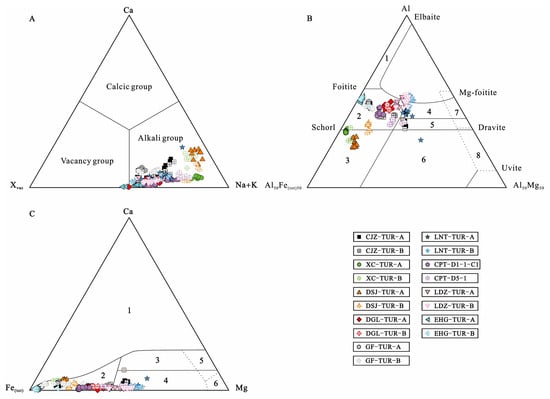
Figure 6.
(A): The classification diagrams of tourmaline from the Bozhushan showing the X-site occupation; (B): Al-Fe-Mg diagram showing compositions of tourmaline from the Bozhushan; (C): Ca-Fe-Mg diagram showing compositions from the Bozhushan [24,25,26]. (B): 1. Li-rich granitoid pegmatites and aplites; 2. Li-poor granitoids and associated pegmatites and aplites; 3. Fe3+-rich quartz–tourmaline rocks and altered granitoids; 4. metapelites and metapsammites with Al-saturating phases; 5. metapelites and metapsammites lacking Al-saturating phases; 6. Fe3+-rich quartz–tourmaline rocks, calc-silicate rocks, and metapelites; 7. low-Ca metaultramafic rocks and Cr, V-rich metasediments; 8. metacarbonates and metapyroxenites. (C): 1. Li-rich granitoid pegmatites and aplites; 2. Li-poor granitoids and associated pegmatites and aplites; 3. Ca-rich metapelites, metapsammites, and calc-silicate rocks; 4. Ca-poor metapelites, metapsammites, and quartz–tourmaline rocks; 5. metacarbonates; 6. metaultramafics.
Tourmaline from the Bozhushan can be categorized into distinct groups according to their chemical ratios, specifically, ratios Fe/(Fe + Mg)-Al, Fe/(Fe + Mg)-Xvac/(Na + K + Xvac), and Fe/(Fe + Mg)-Na/(Na + Ca); the composition corresponds to the schorl-dravite series, with the predominant schorl component. However, some of the data from the samples of LDZ, LNT, and CJZ are distributed in the dravite region, which shows a transition phenomenon from schorl to dravite (Figure 7).
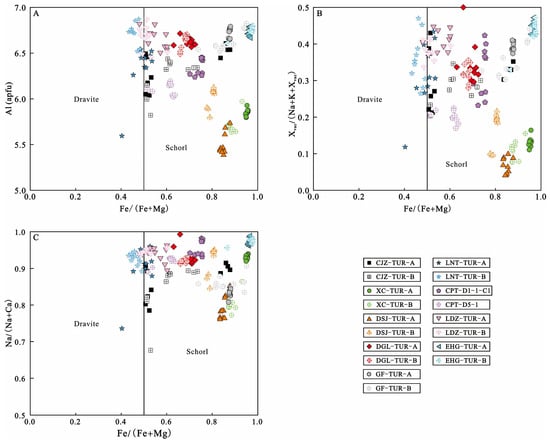
Figure 7.
The classification diagrams of tourmaline from the Bozhushan [24,25,26]. (A) Fe/(Fe + Mg) vs. Al; (B) Fe/(Fe + Mg) vs. Xvac/(Na + K + Xvac); (C) Fe/(Fe + Mg) vs. Na/(Na + Ca).
The majority of elemental substitutions observed in tourmaline occur primarily at the X- and Y-sites. As illustrated in Figure 8, there is a negative correlation between Mg and Fe, indicating that a significant mutual substitution of Mg and Fe2+ occurs at the Y position. In the Al(tot)-Fe (apfu) and Al(tot)-Xvac (apfu) diagrams, the former demonstrates a negative correlation, while the latter exhibits a positive correlation. This suggests that Al enters the Y position primarily through the substitution of (AlO) (FeOH)−1 and (XvacAl) (NaR2+)−1. In the Fe (apfu)-Xvac (apfu) and Mg-Fe diagrams, both correlations are negative, indicating that the substitutional mechanisms are (NaFe2+) (XvacAl)−1 and Fe2+Mg−1, respectively.
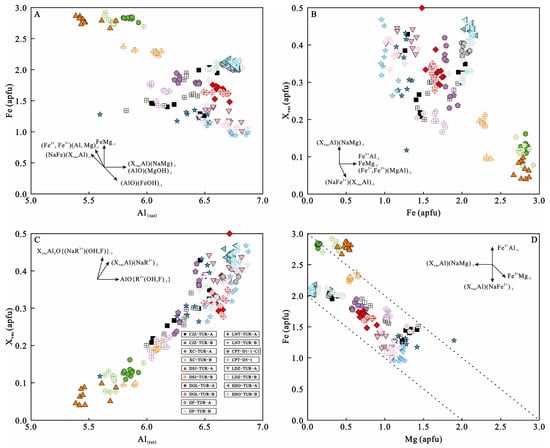
Figure 8.
The diagrams showing the compositional evolution of tourmaline from the Bozhushan [24,26]. (A) Al vs. Fe; (B) Fe vs. Xvac; (C) Al vs. Xvac; (D) Mg vs. Fe.
5.2. Trace and Rare Elements
The analytical data of LA-ICP-MS are shown in Table S3. In this study, tourmaline collected from each unit was compared with the lithology of its corresponding unit [2]. The results of the trace-element data analyses of the nine groups of samples revealed the presence of relatively large elements, e.g., Ba, Rb, Th, U, Pb, etc. In addition, trace elements, including Li (10.72~1036.41 ppm), Sc (6.00~304.71 ppm), Zn (78.03~477.64 ppm), Ga (82.21~193.15 ppm), and Sn (11.86~342.75 ppm) showed significant enrichment in the tourmaline species. Zn and Ga exhibited the highest concentrations, with average values exceeding 100 ppm. Geochemical variations were observed among the different sampling locations: the Li content in the GF, DSJ, DGL, XC, and EHG, and CPT samples showed considerable enrichment (mean values: 86.74, 745.54, 117.67, 96.54, 166.11, and 58.97 ppm, respectively), appearing significantly higher than regional background levels. Conversely, V concentrations in CJZ (276.56 ppm), DGL (49.67 ppm), LNT (244.29 ppm), XC (36.86 ppm), LDZ (47.88 ppm), and CPT (116.39 ppm) showed depletion trends in comparison with other samples.
On the other hand, the total content of the rare earth elements (REEs) in the analyzed samples varied significantly (1.27~132.24 ppm). All samples were enriched in the light REE (LREE) and depleted in the heavy REE (HREE); however, the ratio LREE/HREE (0.00~608.15) showed a great variability among the samples; comparing the ratios of (La/Yb)N, (La/Sm)N, all samples showed an enrichment in light rare earth elements and a deficiency in heavy rare earth elements. The four groups of samples, CJZ, DGL, LNT, and LDZ, showed obvious positive δEu anomalies of 2.11~4.23, 3.11~3.30, 7.21~23.16, and 1.54~25.90, respectively, and the CPT sample also had a positive δEu anomaly of 0.74~3.71. The DSJ, XC, EHG samples showed obvious δEu negative anomalies of 0.04~0.20, 0.05~1.14, and 0.01~0.28, respectively. The GF, DSJ, XC, and EHG samples all showed Ce-positive anomalies (Ce > 1) of 0.97~1.19, 1.02~1.09, 0.98~1.27, and 1.13~1.43, which indicates the oxidizing environments. The remaining samples showed Ce-negative anomalies (Ce < 1), which indicates reducing environments (Figure 9).
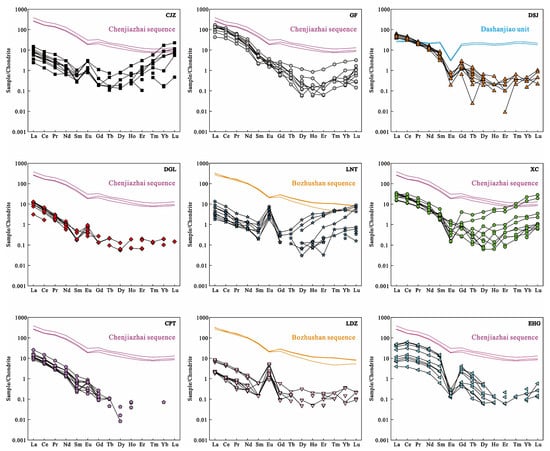
Figure 9.
Standardized rare earth element diagrams of tourmaline from the Bozhushan [27].
5.3. Boron Isotope
The results of the boron isotope analysis of tourmaline are shown in Table S4. Each of the nine samples from the Bozhushan featured 15 analyses (i.e., 135 analyses in total) and resulted in a range from −15.89‰ to −12.66‰. The δ11B values of CPT, CJZ, XC, and DSJ samples evinced lower variability (−13.35‰~−13.02‰, −14.88‰~−14.66‰, −15.27‰~−15.07‰, −14.67‰~−14.21‰, respectively) than the δ11B values of LNT, DGL, GF, EHG, and LDZ. The samples could be generally divided into the three data segments based on the increasing value of δ11B as follows: CPT, DGL, EHG and GF with the δ11B mean values ranging between −13.89‰ and −13.19‰, the group of CJZ, DSJ with the δ11B mean values ranging between −14.75‰ and −14.32‰, and the group of XC and LNT samples with the δ11B mean values ranging between −15.33‰ and −15.18‰ (Figure 10).

Figure 10.
Histogram of boron isotope distribution in tourmaline from the Bozhushan.
6. Discussion
6.1. Genesis- and Magmatic-Hydrothermal Evolution of Tourmaline
Previous studies have pointed out that magmatically derived tourmaline is relatively homogeneous, with no compositional zoning, characterized by high Fe/Mg ratios and a high Al content at the Y-site, whereas hydrothermally derived tourmaline shows fine-scale compositional oscillatory zoning, and is characterized by Mg-rich and none or a low Al content at the Y-site [12].
Some of the tourmaline examined from the Bozhushan show clear, simple rhythmic zoning in both microscopic and electron microprobe backscatter images (Figure 2, Figure 3, Figure 4 and Figure 5). The experimental data show that the Fe/(Fe + Mg) ratio of CJZ ranges from 0.51 to 0.88 apfu, with a mean value of 0.63 apfu, and the Al-content at the Y-site being 0.00~0.45 apfu, with a mean value of 0.22 apfu; the Fe/(Fe + Mg) ratio of XC ranges from 0.87 to 0.96 apfu, with the mean value of 0.92 apfu, and the Al-content at the Y-site being 0 apfu, with a mean value of 0 apfu; the Fe/(Fe + Mg) ratio of DSJ ranges from 0.78 to 0.88 apfu, with a mean value of 0.82 apfu, and the Al-content at the Y-site is 0~0.08 apfu, with a mean value of 0.02 apfu; the Fe/(Fe + Mg) ratio of DGL ranges from 0.63 to 0.73 apfu, with a mean value of 0.69 apfu, and the Al-content at the Y-site is 0.35~0.64 apfu, with a mean value of 0.45 apfu; the Fe/(Fe + Mg) ratio of GF ranges from 0.74 to 0.95 apfu, with a mean value of 0.87 apfu, and the Al-content at the Y-site is 0.34~0.66 apfu, with a mean value of 0.48 apfu; the Fe/(Fe + Mg) ratio of LNT ranges from 0.40 to 0.54 apfu, with a mean value of 0.48, and the Al-content at the Y-site is 0.00~0.77 apfu, with a mean value of 0.47 apfu; the Fe/(Fe + Mg) ratio of CPT ranges from 0.52 to 0.76, with a mean value of 0.67 apfu, and the Al-content at the Y-site is 0.00~0.45 apfu, with a mean value of 0.20 apfu; the Fe/(Fe + Mg) ratio of the LDZ ranges from 0.48 to 0.60 apfu, with a mean value of 0.54 apfu, and the Al-content at the Y-site is 0.43~0.78 apfu, with a mean value of 0.60 apfu; and the Fe/(Fe + Mg) ratio of the EHG ranges from 0.87 to 0.98 apfu, with a mean value of 0.96 apfu, and Al-content at the Y-site is 0.42~0.73 apfu, with a mean value of 0.60 apfu. Among the Y-sites, the samples from CJZ, XC, DSJ, and CPT are characterized by a low-to-no Al-content, while other samples show a higher Al content, reflecting on the fact that the formation process of tourmaline is mainly dominated by magmatism and affected by hydrothermal action after the magmatic period. Fe-rich tourmaline predominantly crystallizes within proximal zones of parental magma chambers, exhibiting systematic Fe-Mg substitution trends controlled by magmatic–hydrothermal evolution. Geochemical gradients such as the Fe/(Fe + Mg) ratio decrease progressively from the early magmatic to late hydrothermal stages. This elemental fractionation reflects initial Fe-rich compositions forming under high fO2 in fractionated pegmatitic melts, followed by Mg enrichment via fluid-mediated Mg-metasomatism during the hydrothermal overprint [28,29,30,31,32,33]. In this study, the samples of DSJ, XC, GF, and EHG are more consistent with this feature. In Figure 8, the LNT and LDZ samples show dravite characteristics, which is partly due to the late Mg enrichment of tourmaline and partly due to the contact metamorphism between the magma and Mg-bearing rocks such as sandstone in the surrounding Cambrian unit [34].
Figure 9 shows two major sequences (Chenjiazhai and Bozhushan) and the Dashanjiao unit in the Bozhushan with a right-dipping trend, characterized by LREE enrichment (chondrite-normalized enrichment), quasi-depleted HREE, and prominent Eu-negative anomalies. In Figure 9, most samples (CJZ, DGL, LNT, LDZ, CPT) exhibit slight LREE enrichment over HREE and distinct Eu-positive anomalies. Previous research has indicated that tourmaline prefers to bind Eu2+ rather than Eu3+ [10]. The Bozhushan granite has a slight Eu-negative anomaly feature (Figure 9); on the other hand, the Eu anomaly in some types of tourmaline shows the opposite trend. A relevant study indicated that when the temperature is higher than 250 °C, the hydrothermal fluids contain mainly Eu2+, so tourmaline which crystallized from such a hydrothermal fluid should contain Eu2+ as well [35], which is consistent with magmatogenically originated tourmaline characteristics. In addition, tourmaline shows a strong and positive Eu anomaly feature, which suggests that the hydrothermal fluids are in a reduced state. It is evident that positive Eu anomalies are concomitant with negative Ce anomalies, thus indicating relatively elevated levels of fO2 at the time of their formation [36]. However, there are still contradictions in the above-mentioned statements [37]. The valence state of Eu is contingent on the redox conditions under which tourmaline is formed. Tourmaline can concentrate Eu during the crystallization process; all of the Eu may be present in the tourmaline structure as a trivalent cation. Eu3+-rich tourmaline should not be entirely excluded from consideration in natural occurrences [38].
In order to better observe the elemental variations, we compared the trace elements (Li/Sr ratios) of tourmaline from the Bozhushan as a proxy for the fluid source with the results of a previous study (Figure 11) [39]. The results show that the samples from EHG and DSJ are situated within the magmatic tourmaline zone; the samples from LNT and CJZ are more inclined to metamorphic tourmaline, and the rest of the samples are situated within the magmatic tourmaline–metamorphic tourmaline overlap zone, which suggests that the fluid that formed the tourmaline is mainly of magmatic origin and that its metamorphic characteristics are not only related to the degree of metamorphism of the host rock but also to the mixing of the host rock and partially equilibrated fluids with external fluids [39].

Figure 11.
Diagrams showing the relationship between the Li/Sr ratio and V-, Zn- and Li-contents in tourmaline from the Bozhushan [36,39]. (A) Li/Sr vs. V; (B) Li/Sr vs. Li; (C) Li/Sr vs. Zn.
Among the trace elements of tourmaline, variations in the V-content have been used as an indication of the relative timing of tourmaline formation [40,41] because the V-content is preferentially fractionated into ilmenite and mica during magma crystallization and preferentially partitioned into tourmaline in the melt [10]. The samples from GF, DSJ, and EHG all have a relatively low V-content (0.20~4.93 ppm, 0.25~4.91 ppm, and b.d.l.~15.39 ppm, respectively), which may indicate the early formation of tourmaline. Previous studies found that atmospheric precipitation may have brought V into the hydrothermal system, leading to a sharp increase in the V content in the late hydrothermal stage, along with elements such as Co, Sr, and Zn. A similar phenomenon was observed in this study, with a significant V-content, particularly in the samples from the LNT (V = 182.25~533.76 ppm), which may indicate that this genesis may be related to late immiscible boron-rich melts or fluids accounting for early magmatic minerals, thus representing the magmatic–hydrothermal transition stage [42,43,44,45].
It is common to use boron isotopes of tourmaline for studies of mineralization and deposit geneses in granite and various types of hydrothermal deposits and to use the δ11B values of tourmaline for comparisons with crustal boron protoliths [46,47,48,49]. It has been shown that continental crust is significantly enriched in light boron compared to oceanic crust. Most continental crustal rocks have negative δ11B values, with a large difference between the boron isotopes of I-type magmatism (mean value of −2‰) and S-type magmatism (most of the δ11B is −8‰~−20‰) [50]. The δ11B values of tourmaline in the studied samples from the Bozhushan fall within the range of −15.89‰~−12.66‰, which indicates that tourmaline originates from granitic rocks related to S-type magmatism. This is in agreement with the results of the geochemical characterization of the Bozhushan granite by previous researchers [2,3,51]. Previous studies found that tourmaline in granite derived from crustal source sediments has very similar δ11B values, which is very close to the mean value of δ11B for the continental crust (−10‰ ± 3‰) (Figure 12) [52]. The mean value of δ11B (−15.33‰~−13.19‰) of the tourmaline from the Bozhushan is relatively close to the mean value of the continental crust, which, in combination with the characteristics of the S-type granite from the Bozhushan, reflects that the source area was likely metamorphosed sedimentary rock [50,53,54]. In addition, the distribution of boron isotopes is relatively homogeneous, which may indicate a more stable source of boron [53,54]. Furthermore, tectonic activities have been demonstrated to trigger the local upwelling of mantle source magmas. In the area of the Bozhushan, the intrusion of granitic magma during the late Yanshan period resulted in the melting of the upper crust and the production of a substantial quantity of boron-rich melts. These melts subsequently provided an effective element supply for tourmaline crystallization [55,56].
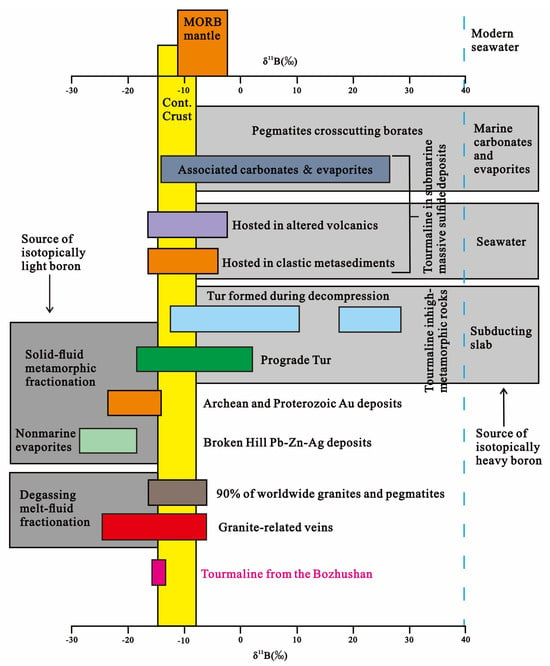
Figure 12.
Measured boron isotope composition as a function of host rock type and inferred B sources [52].
6.2. Significance of Mineralization
Within most of the Late Cretaceous region of western South China, there was a phase of magmatic events controlled by the same dynamical setting (i.e., large-scale lithospheric extensional action). In such an extensional tectonic context, lithospheric extension caused crustal thinning and soft fluvial upwelling, resulting in magma upwelling and leading to lower crust melting. The Late Cretaceous magmatic intrusion activities brought a number of mineralizing components. With the continuous crystallization and differentiation of magma, the granitic magma of the Bozhushan formed an ore-forming magma flow containing a variety of metallogenic elements, which intruded into the Cambrian system during the upwelling of the magma and reacted with the carbonate rocks to form tungsten–tin mineralization [3,4,16,19,56,57,58]. Previous studies have shown that tourmaline can indicate a rock-forming environment and mineralization, and its geochemical characteristics can respond to the formation of tin and tungsten–tin deposits [44,46,59,60].
Previous studies found that the content of Sn in tourmaline can be used in Sn-mineralized granite to reflect Sn-rich and Sn-poor granite using the ratios of Co/La, Co/Nb, and Zn/Nb. In this study, most of the experimental data fall in the vicinity of Sn mineralized granite, which corresponds to the results of the previous research [61], which suggests that this area has a very good potential for mineralization (Figure 13).

Figure 13.
Element ratio diagrams (Zn/Nb, Co/Nb, Co/La) in tourmaline associated with Sn Mineralization from the Bozhushan [61]. (A) Sn vs. Zn/Nb; (B) Sn vs. Co/La; (C) Sn vs. Co/Nb.
Previous studies concluded that Fe# values (FeO/(FeO + MgO)) can clearly distinguish W-Sn deposits as either proximal or distal in relation to the parent granite, as follows: a high Fe# (>0.8) content is a sign of endogranitic mineralization (close to the parent granite), while a low Fe# (<0.6) content is a sign of exogranitic mineralization (distant from the parent granite more than 1 km). The intermediate Fe# values (0.8~0.6) represent mineralization at less than 1 km but still exogranitic [62]. These data offer a more precise indication of the relationship between granite-related deposits and tourmaline. For instance, the Fe# values of tourmaline in the Nanyangtian mining area in southeastern Yunnan range from 0.38 to 0.73, and the MgO values are distributed between 6 and 9 wt.%. These findings suggest that the medium-distance source from the rock body varies from a few hundred meters to 1 km and that this area is favorable to mineralization. Furthermore, the present study observed that hydrothermal fluids, which coexisted with tourmaline, exhibited a notable superposition onto the primary ore body, thereby augmenting the process of superimposed mineralization [54]. Tourmaline from the Western Anatolian region of Turkey has Fe# values ranging from 0.5 to 0.7 and MgO values ranging from 6 to 9 wt.%, suggesting that the tourmaline is derived from near-to-intermediate-distant veins [63]. The Fe# values of tourmaline in the Dayakou emerald deposits in southwestern China are predominantly less than 0.6, and the MgO values are distributed between 6 and 10 wt.%. These characteristics suggest that the deposits are likely to be an ideal target for emerald exploration [64]. Tourmaline from the Bozhushan has an Fe# content of 0.55~0.99, and all sample points in the FeO/(FeO + MgO)-MgO diagram fall within the proximal and intermediate fields, suggesting that the medium-distance source of a few hundred meters to 1 km from the rock body is favorable to mineralization (Figure 14).
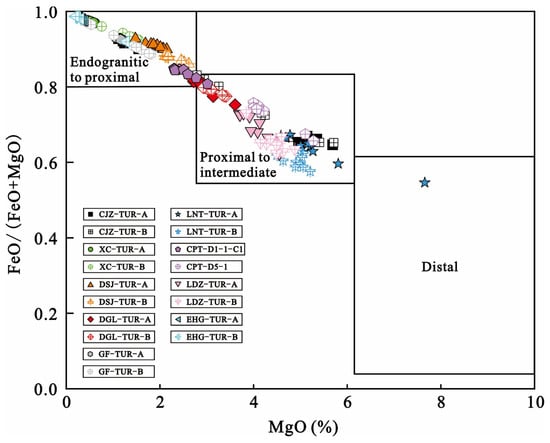
Figure 14.
Fe#/MgO diagram showing the distance of Sn-W mineralization from the parent granite based on the tourmaline composition [62].
Previous research shows that the Fe# values of tourmaline from different ore-bearing rocks can be used to find out the distribution pattern of the rocks, and the values can also be used to approximate the proximity of a certain kind of rock to the granite body [65]. In Figure 15, this study analyzes the relationship between Fe and Fe#, because the ratio of Fe to Fe# shows a better agreement, which corresponds to the characteristics present in Figure 14. The characteristics of tourmaline from the Bozhushan indicate that the larger the Fe# value, the richer the mineralization potential. Of course, the geological conditions vary from one mining area to another, and the Fe# value may be affected by the surrounding rocks; therefore, when using this law, it should be evaluated in conjunction with the geological environment within the mining area. A substantial amount of research has demonstrated the potential of the geochemical characteristics of tourmaline to facilitate tin ore detection, with particular emphasis on the values of Sn (Sn > 100 ppm) and Fe# (Fe# > 0.8) [66]. The samples examined in this study, originating from XC, is in agreement with these characteristics, thereby indicating the persistent possibility of tin ore formation in the studied region.
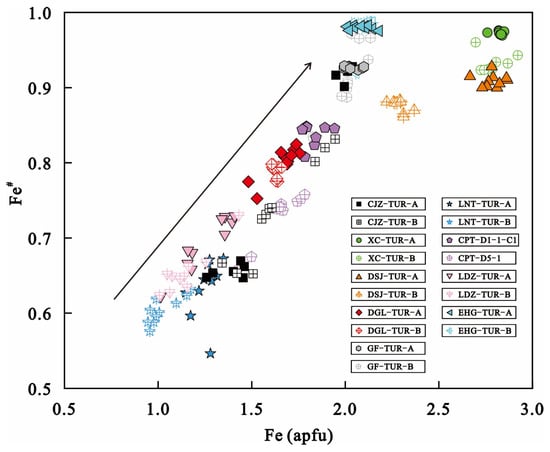
Figure 15.
Diagrams showing the relationship between Fe and Fe# variation in tourmaline from the Bozhushan.
During the recent field investigation, several significant findings were obtained. For instance, scheelite mineralization was sporadically observed on the surface of the EHG samples, where minor scheelite was found in association with schorl under a hand lens (Figure 16A). In the mining audits near the EHG sampling site, abundant biotite monzogranite veins were identified. These veins contained schorl exhibiting pocket-like-to-s nodular textures, partially showing disseminated patterns. The veins were intersected by skarn, with well-developed scheelite mineralization observed in the adjacent skarn zones (Figure 16B,C). Additionally, scheelite with star-like distribution was discovered in the skarn near the CPT sampling site (Figure 16D,E). The CPT samples exhibited intrusive contact with these mineralized zones. Within the pegmatite of CPT samples, metallic minerals such as pyrrhotite and pyrite were also identified (Figure 16F). A preliminary analysis suggested that the vein activities in this area indicate potential magmatic-hydrothermal activity, which may represent a mineralization overprinting event contributing to the further enrichment of the local ore bodies.
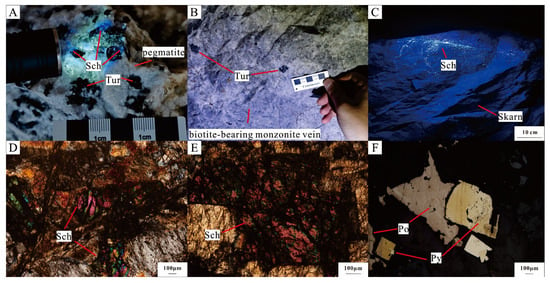
Figure 16.
Hand specimens and field characteristics of related minerals and tourmaline-bearing rocks from the Bozhushan. (A): Tourmaline-bearing pegmatite containing star-shaped scheelite; (B): biotite-bearing adamellite vein containing tourmaline; (C): scheelite veinlets in skarn; (D,E): scheelite under a microscope; and (F): pyrite and pyrrhotite in pegmatites from CPT samples. Tur—tourmaline; Po—pyrrhotite; Py— pyrite; Sch—scheelite.
In summary, this study concludes that the Changputang-Guanfang area and its surrounding regions in the western part of the Bozhushan still have a large potential for mineralization, and tourmaline can be considered a mineralization indicator.
7. Conclusions
- (1)
- This article focuses on two types of tourmaline from the Bozhushan area: tourmaline in granitic pegmatites and tourmaline in granitic aplites. The classification of tourmaline from the Bozhushan is primarily determined by chemical compositions. Most of the tourmaline was classified as schorl and dravite. More specifically, the EHG samples differ by the evolution towards schorl–foitite, and the LNT, LDZ, and CJZ samples belong to the schorl–dravite series. The formation process of tourmaline is dominated by magmatism and is characterized by the magmatic–hydrothermal transition. Most of the tourmaline compositions belong to the alkali subgroup formed in Li-poor granitoids and associated pegmatites and aplites, Ca-poor metapelites, metapsammites, and quartz–tourmaline rocks, with elemental substitutions dominated by Fe2+Mg−1 and (XvacAl) (NaR2+)−1. Moreover, the trace elements of tourmaline indicate that the tourmaline composition is not only related to the host rock but also affected by the external environment; the rare earth element map of tourmaline shows an enrichment of light rare earth elements and a deficiency in heavy rare earth elements, indicating the processes of fractionation.
- (2)
- Tourmaline from the Bozhushan exhibits δ11B values ranging from −15.89‰ to 12.66‰, overlapping with both granite-related tourmaline and typical S-type granite ranges. The boron isotopic compositions show tower-shaped histogram distributions, closely resembling the continental crustal reservoir. This signature indicates a homogeneous boron source dominantly derived from the metamorphosed sedimentary sequence.
- (3)
- The geochemistry of the tourmaline from the Bozhushan indicates that this area has excellent mineralization potential, which may be associated with the magmatic intrusion activities that occurred during the Late Cretaceous period. The interaction between post-magmatic–hydrothermal fluids and carbonate rocks has been demonstrated by the precipitation and enrichment of mineralized elements.
Supplementary Materials
The following supporting information can be downloaded at https://www.mdpi.com/article/10.3390/min15030316/s1. Table S1: Lithological Sequences and Lithofacies Units of the Bozhushan; Table S2: Major Element Geochemistry of Tourmaline from the Bozhushan (wt.%); Table S3: Trace and Rare Earth Element Geochemistry of Tourmaline from the Bozhushan (×10−6); Table S4: Boron Isotopic Composition (δ11B) of Tourmaline from the Bozhushan.
Author Contributions
Conceptualization, X.C. and L.C.; Methodology, S.Z. and X.L.; Software, Q.S.; Validation, X.C. and L.C.; Formal analysis, L.S.; Investigation, X.C., B.L. and J.Z.; Resources, X.L.; Data curation, X.C.; Writing—original draft, X.C.; Writing—review & editing, S.Z.; Visualization, R.Z.; Project administration, S.Z. and X.L.; Funding acquisition, S.Z. and X.L. All authors have read and agreed to the published version of the manuscript.
Funding
This research was funded by “Double First-Class” Research Initiative in Science and Technology, Kunming University of Science and Technology: Late Yanshan Period Magmatic-Hydrothermal Mineralization System and Metallogenic Regularities of the Bozhushan Ore Field (202202AG050006-2); Yunnan Provincial High-Level Scientific Talent Recruitment and Innovation Team Development Program (202305AT350004-4); Yunnan Sanjiang Metallogenic System and Evaluation Top Team Development Project (202305AS350015); Study on Metallogenic Regularities and Deep-Peripheral Prospecting Prediction of Sn-Ag-Pb-Zn-W Polymetallic Deposits in the Western Depression Zone of Bozhushan Granite, Southeastern Yunnan (Y202407).
Data Availability Statement
Data are contained within the article and Supplementary Materials.
Acknowledgments
We would like to express their sincere gratitude to Jun Zhu and Yimin Tian from Kunming University of Science and Technology for their invaluable suggestions during the writing process. We also extend our heartfelt thanks to Fanglan Li from the China University of Geosciences (Wuhan) for her meticulous guidance on mineral chemical formulas.
Conflicts of Interest
Qiuyun Song is an employee of Kunming Prospecting Design Institute of China Nonferrous Metals Industry Co., Ltd., and Linlong Sun is an employee of Yunnan Gaozheng Geological Exploration Co., Ltd. The paper reflects the views of the scientists and not the company.
References
- Zhang, H.P.; Liu, J.S.; Li, X.B.; Zhang, X.L. Relationship of granites to tin, silver, copper, lead, zinc, polymetallic deposits in southeastern Yunnan, China. Contrib. Geol. Miner. Resour. Res. 2006, 21, 87–90. [Google Scholar]
- Zhang, S.T.; Chen, G.C. The geological features and evolution of the Bozhu MT complex granite body in SE Yunnan. Yunnan Geol. 1997, 16, 222–232. [Google Scholar]
- Zhang, Y.H. Study on the Late Yanshanian Acidic Magmatic Hydrothermal Mineralization in Bozhushan, Southeast Yunnan. Ph.D. Thesis, Kunming University of Science and Technology, Kunming, China, 2013. [Google Scholar]
- Cheng, Y.B.; Mao, J.W.; Chen, X.L.; Li, W. LA-ICP-MS Zircon U-Pb Dating of the Bozhushan Granite in Southeastern Yunnan Province and Its Significance. J. Jilin Univ. Earth Sci. Ed. 2010, 40, 869–878. [Google Scholar]
- Zhang, K.Y.; Cheng, X.H.; Qu, H.L. Present situation of research and development of tourmaline and its application future at home and abroad. Min. Metall. 2004, 13, 97–100. [Google Scholar]
- Zhang, L.; WU, Y.; Xiao, B.; Li, X.D. Research on the Composition, Structure and Deep Processing Technology of Tourmaline. Multipurp. Util. Miner. Resour. 2009, 4, 30–34. [Google Scholar] [CrossRef]
- Hu, Y.M.; Chen, X.B.; Tang, M.R. Research development and prospects of functional tourmaline composites. Earth Sci. Front. 2014, 21, 331–337. [Google Scholar] [CrossRef]
- He, G.H. The Microstructure Classification, Color Alteration and Modification of Tourmaline. Ph.D. Thesis, China University of Geosciences, Wuhan, China, 2017. [Google Scholar]
- Henry, D.J.; Dutrow, B.L. Metamorphic tourmaline and its petrologic applications. Rev. Mineral. 1996, 33, 503–557. [Google Scholar]
- Hinsberg, V.V.; Henry, D.; Marschall, H. Tourmaline: An ideal indicator of its host environment. Elements 2010, 6, 59. [Google Scholar] [CrossRef]
- Buriánek, D.; Novák, M. Compositional evolution and substitutions in disseminated and nodular tourmaline from leucocratic granites: Examples from the Bohemian Massif, Czech Republic. Lithos 2007, 95, 148–164. [Google Scholar] [CrossRef]
- Huang, X.F.; Zhang, B.L.; Li, X.L.; Shen, X.L.; Guo, Z.H. Research progress of tourmaline and its prospecting significance. Gold Sci. Technol. 2012, 20, 56–65. [Google Scholar]
- Da Costa, I.R.; Mourão, C.; Récio, C.; Guimarães, F.; Antunes, I.M.; Farinha Ramos, J.; Barriga, F.J.A.S.; Palmer, M.R.; Milton, J.A. Tourmaline occurrences within the Penamacor-Monsanto granitic pluton and host-rocks (Central Portugal): Genetic implications of crystal-chemical and isotopic features. Contrib. Mineral. Petrol. 2014, 167, 993. [Google Scholar] [CrossRef]
- 1:50,000 Geological Report of Laojiezi; Yunnan Bureau of Geology and Mineral Resources: Kunming, China.
- 1:50,000 Geological Report of Laozhaijie; Yunnan Bureau of Geology and Mineral Resources: Kunming, China.
- Li, X.B. The Ore-Forming Geological Feature and Metallogenic Pattern of Bainiuchang Poly-Metal Deposit in Mengzi, Yunnan, China. Master’s Thesis, Central South University, Changsha, China, 2005. [Google Scholar]
- Xie, H.J.; Zhang, Q.; Zhu, C.H.; Fan, L.W.; Wang, D.P. Petrology and REE-Trace Element Geochemistry of Bozhushan Granite Pluton in Southeastern Yunnan Province, China. Acta Mineral. Sin. 2009, 29, 481–490. [Google Scholar]
- Liu, Y.; Kong, Z.G.; Chen, G.; Shao, F.L.; Tang, Y.W.; Sun, B.; Yang, G.S.; Cai, J.D. In-situ LA-SF-ICP-MS U-Pb dating of garnet from Guanfang tungsten deposit in southeastern Yunnan Province and its geological significance. Acta Petrol. Sin. 2021, 37, 847–864. [Google Scholar] [CrossRef]
- Zhang, H.P. Bainiuchang Super-Large Sliver-Polymetallic Ore Deposit Related to Granitic Magmatism in Mengzi, Yunnan, China. Ph.D. Thesis, Central South University, Changsha, China, 2007. [Google Scholar] [CrossRef]
- Zhang, L.; Liang, L. Genesis of pegmatite and aplite: Rare metal granite study of Limu in Guangxi. J. Guilin Univ. Technol. 2018, 38, 175–188. [Google Scholar]
- London, D. Ore-Forming Processes Within Granitic Pegmatites. Ore Geol. Rev. 2018, 101, 349–383. [Google Scholar] [CrossRef]
- Zhou, Q.F.; Qin, K.Z.; Tang, D.M.; Wang, C.L.; Ma, L.S. Mineralogical characteristics and significance of beryl from the rare-element pegmatites in the Lushi County, East Qinling, China. Acta Petrol. Sin. 2019, 35, 1999–2012. [Google Scholar] [CrossRef]
- Hou, K.J.; Li, Y.H.; Xiao, Y.K.; Liu, F.; Tian, Y.R. In situ boron isotope measurements of natural geological materials by LA-MC-ICP-MS. Chin. Sci. Bull. 2010, 55, 3305–3311. [Google Scholar] [CrossRef]
- Henry, D.J.; Novak, M.; Hawthorne, F.C.; Hawthorne, F.C.; Ertl, A.; Dutrow, B.L.; Uher, P.; Pezzotta, F. Nomenclature of the tourmaline-supergroup minerals. Am. Mineral. 2011, 96, 895–913. [Google Scholar] [CrossRef]
- Rodrigues, I.C.; Mizusaki, A.M.; Queiroga, G.; Michelin, C.R.; Rios, F.R. Provenance of volcano-sedimentary features using tourmaline and REE compositional analysis, in the Paraná Basin, southern Brazil. J. South Am. Earth Sci. 2024, 137, 104843. [Google Scholar] [CrossRef]
- Guo, M.X.; Liu, J.J.; Zhai, D.G.; Fourestier, J.D.; Liu, M.; Zhu, R. Tourmaline as an indicator of ore-forming processes: Evidence from the laodou gold deposit, northwest China. Ore Geol. Rev. 2023, 154, 105304. [Google Scholar] [CrossRef]
- Sun, S.S.; McDonough, W.F. Chemical and isotopic systematics of oceanic basalts: Implications for mantle composition and processes. Geol. Soc. Spec. Publ. 1989, 42, 313–345. [Google Scholar] [CrossRef]
- Sun, H.T.; Ge, C.H.; Ji, S.K. Tourmaline from the Zhongtiaoshan Copper Metallogenic Area: Its Characteristics and Indication Significance for Ore-forming Process of That Area. Acta Petrol. Mineral. 1989, 8, 232–242. [Google Scholar]
- Trumbull, R.B.; Chaussidon, M. Chemical and boron isotopic composition of magmatic and hydrothermal tourmalines from the Sinceni granite-pegmatite system in Swaziland. Chem. Geol. 1999, 153, 125–137. [Google Scholar] [CrossRef]
- Longfellow, K.M.; Swanson, S.E. Skeletal tourmaline, undercooling, and crystallization history of the Stone Mountain granite, Georgia, U.S.A. Can. Mineral. 2010, 49, 341–357. [Google Scholar] [CrossRef]
- Siegel, K.; Wagner, T.; Trumbull, R.B.; Jonsson, E.; Matalin, G.; Wälle, M.; Heinrich, C.A. Stable isotope (B, H, O) and mineral chemistry constraints on the magmatic to hydrothermal evolution of the Varuträsk rare-element pegmatite (Northern Sweden). Chem. Geol. 2016, 421, 1–16. [Google Scholar] [CrossRef]
- Hazarika, P.; Upadhyay, D.; Pruseth, K.L. Episodic tourmaline growth and re-equilibration in mica pegmatite from the Bihar mica belt, India: Major- and trace-element variations under pegmatitic and hydrothermal conditions. Geol. Mag. 2017, 154, 68–86. [Google Scholar] [CrossRef]
- Zheng, B.Q.; Chen, B.; Sun, Y. Tracing the evolution of the pegmatite system and its interaction with the country rocks by chemical and boron isotope compositions of tourmaline in the Qinghe pegmatite from the Chinese Altay orogen. Acta Petrol. Sin. 2023, 39, 187–204. [Google Scholar] [CrossRef]
- Huang, X.Y.; Zhang, H.; Tang, Y.; Guan, S.J. Chemical Composition of Tourmailines from the B-Rich Granite and Miarolitic Cavities in Yinping, Guangxi and its Implications for Evolution of the Magmatic-Hydrothermal System. Acta Petrol. Sin. 2008, 28, 25–34. [Google Scholar] [CrossRef]
- Sverjensky, D.A. Europium redox equilibria in aqueous solution. Earth Planet. Sci. Lett. 1984, 67, 70–78. [Google Scholar] [CrossRef]
- Li, F.L.; Liu, X.L.; Li, S.K.; Wang, J.Y.; Lu, B.D.; Li, Q.R.; Zhang, W.W.; Wang, H.; Cao, Z.L.; Zhou, J.H. Geochemical characteristics of tourmaline in the Jinchanghe iron-copper lead-zinc polymetallic deposit in the Baoshan block in the western Yunnan. Acta Mineral. Sin. 2024, 44, 911–926. [Google Scholar] [CrossRef]
- Zheng, F.S.; Song, G.X. Application of Eu anomaly in Geology. Acta Petrol. Sin. 2023, 39, 2832–2856. [Google Scholar] [CrossRef]
- Vereshchagin, O.S.; Britvin, S.N.; Wunder, B.; Frank-Kamenetskaya, O.V.; Wilke, F.; Vlasenko, N.S.; Shilovskikh, V.V.; Bocharov, V.N.; Danilov, D.V. Ln3+ (Ln3+ = La, Nd, Eu, Yb) incorporation in synthetic tourmaline analogues: Towards tourmaline REE pattern explanation. Chem. Geol. 2021, 584, 120526. [Google Scholar] [CrossRef]
- Harlaux, M.; Kouzmanov, K.; Gialli, S.; Laurent, O.; Rielli, A.; Dini, A.; Chauvet, A.; Menzies, A.; Kalinaj, M.; Fontboté, L. Tourmaline as a Tracer of Late-Magmatic to Hydrothermal Fluid Evolution: The World-Class San Rafael Tin (-Copper) Deposit, Peru. Econ. Geol. 2020, 115, 1665–1697. [Google Scholar] [CrossRef]
- Drivenes, K.; Larsen, R.B.; Müller, A.; Sørensen, B.E.; Wiedenbeck, M.; Raanes, M.P. Late-magmatic immiscibility during batholith formation: Assessment of B isotopes and trace elements in tourmaline from the Land’s End granite, SW England. Contrib Miner. Petrol. 2015, 169, 56. [Google Scholar] [CrossRef]
- Yang, S.Y.; Jiang, S.Y.; Zhao, K.D.; Dai, B.Z.; Yang, T. Tourmaline as a recorder of magmatic–hydrothermal evolution: An in situ major and trace element analysis of tourmaline from the Qitianling batholith, South China. Contrib. Miner. Petrol. 2015, 170, 42. [Google Scholar] [CrossRef]
- Jiang, S.Y.; Han, F.; Shen, J.Z.; Palmer, M.R. Chemical and Rb–Sr, Sm–Nd isotopic systematics of tourmaline from the Dachang Sn-polymetallic ore deposit, Guangxi Province, P.R. China. Chem. Geol. 1999, 157, 49–67. [Google Scholar] [CrossRef]
- Hu, D.L.; Jiang, S.Y. In-situ elemental and boron isotopic variations of tourmaline from the Maogongdong deposit in the Dahutang W-Cu ore field of northern Jiangxi Province, South China: Insights into magmatic-hydrothermal evolution. Ore Geol. Rev. 2020, 122, 103502. [Google Scholar] [CrossRef]
- Guo, J.; Yan, H.B.; Ling, M.X.; Zhang, R.Q. Chemical composition of tourmaline in the biotite granite, the Dachang district: Insights into magmatic-hydrothermal evolution. Acta Petrol. Sin. 2020, 36, 171–183. [Google Scholar] [CrossRef]
- Ren, H.Y.; Li, C.; Jiang, X.J.; Yang, F.C.; Han, Z.; Lu, L.; Chen, Y.K. Geochemical Composition and Boron Isotope Characteristics of Tourmalines in the Gejiu Tin Polymetallic Mining Area, Yunnan Province: Constraints on the Properties and Evolution of Ore-forming Fluids. Acta Geosci. Sin. 2024, 45, 575–590. [Google Scholar] [CrossRef]
- Jiang, S.Y.; Yu, J.; Ni, P.; Ling, H.F. Tourmaline-A Sensitive Tracer for Petrogenesis and Minerogenesis. Geol. Rev. 2000, 46, 594–604. [Google Scholar] [CrossRef]
- Xiao, J.; Xiao, Y.K.; Jin, Z.D.; He, M.Y.; Liu, C.Q. Boron Isotope Variations and Its Geochemical Application in Nature. Aust. J. Earth Sci. 2013, 60, 431–447. [Google Scholar] [CrossRef]
- Foster, G.L.; Marschall, H.R.; Palmer, M.R. Boron Isotope Analysis of Geological Materials. In Advances in Isotope Geochemistry; Marschall, H., Foster, G., Eds.; Springer: Cham, Switzerland, 2018. [Google Scholar] [CrossRef]
- Ji, M.; Gao, X.Y.; Chen, Y.X.; Tu, C.; Sun, G.C.; Gong, B.; Zha, X.P.; Zheng, Y.F. Boron isotope behavior during metamorphic dehydration and partial melting of continental crust: Constraints from tourmaline in metapelites and leucocratic dikes, Himalayan orogen. Geochim. Cosmochim. Acta 2023, 362, 1–21. [Google Scholar] [CrossRef]
- Dai, Z.W.; Li, G.M.; Ding, J.; Zhang, L.K.; Cao, H.W.; Zhang, Z.; Liang, W. Chemical and Boron Isotopic Composition, and Significance of Tourmaline from the Cuonadong Tourmaline Granite, Tibet. Earth Sci. 2019, 44, 1849–1859. [Google Scholar] [CrossRef]
- Huang, J.G.; Ren, T.; Liu, H.W.; Luo, G.M.; Guan, S.J. Geochronology and geochemical characteristics of the Bozhushan granite in the southeastern Yunnan and their geological significances. Bull. Mineral. Petrol. Geochem. 2024, 43, 621–635. [Google Scholar] [CrossRef]
- Marschall, H.R.; Jiang, S.Y. Tourmaline Isotopes: No Element Left Behind. Elements 2011, 7, 313–319. [Google Scholar] [CrossRef]
- Guo, H.F.; Xia, X.P.; Wei, G.J.; Wang, Q.; Zhao, Z.H.; Huang, X.L.; Zhang, H.X.; Yuan, C.; Li, W.X. LA-MC-ICPMS in-situ boron isotope analyses of tourmalines from the Shangbao granites (southern Hunan Province) and its geological significance. Geochimica 2014, 43, 11–19. [Google Scholar]
- Zhang, L.K.; Zhang, B.; Zhang, B.H.; Li, G.M.; Chen, M.H.; Shi, H.Z.; Cao, H.W.; Zhang, S.T. Chemical and boron isotopic composition of hydrothermal tourmaline from Nanyangtian tungsten deposit, Yunnan: Implications for ore genesis. Miner. Depos. 2018, 37, 481–501. [Google Scholar]
- Bosi, F.; Naitza, S.; Skogby, H.; Secchi, F.; Conte, A.M.; Cuccuru, S.; Hålenius, U.; De La Rosa, N.; Kristiansson, P.; Charlotta Nilsson, E.J.; et al. Late magmatic controls on the origin of schorlitic and foititic tourmalines from late-Variscan peraluminous granites of the Arbus pluton (SW Sardinia, Italy): Crystal-chemical study and petrological constraints. Lithos 2018, 308, 395–411. [Google Scholar] [CrossRef]
- Bosi, F.; Naitza, S.; Secchi, F.; Conte, A.M.; Cuccuru, S.; Andreozzi, G.B.; Skogby, H.; Hålenius, U. Petrogenetic controls on the origin of tourmalinite veins from Mandrolisai igneous massif (central Sardinia, Italy): Insights from tourmaline crystal chemistry. Lithos 2019, 342, 333–344. [Google Scholar] [CrossRef]
- Liu, X.L.; Li, W.C.; Zhang, S.T.; Long, Q.H.; Meng, G.Z.; Zhang, H.; Zhou, J.H.; Cheng, J.L.; Zhu, J.; Lu, B.D.; et al. The Late Cretaceous magmatism and Sn-Ag-Pb-Zn-W polymetallic mineralization in Bozhushan ore concentration area, southeast Yunnan. Sediment. Geol. Tethyan Geol. 2024, 44, 437–453. [Google Scholar] [CrossRef]
- Zhang, L. Analysis of Geological Conditions for the Formation of Skarn-Type Tungsten-Tin Polymetallic Deposits in the Southwest of the Bozhushan Granite Massif in Southeastern Yunnan. Master’s Thesis, Kunming University of Science and Technology, Kunming, China, 2014. [Google Scholar]
- Jiang, S.Y.; Palmer, M.R. Boron isotope systematics of Tourmaline from granites and pegmatites: A synthesis. Eur. J. Mineral. 1998, 10, 1253–1265. [Google Scholar] [CrossRef]
- Mao, J.W.; Wang, P.A.; Wang, D.H.; Bi, C.S. The Tracer of Tourmaline for Rock-forming and Metallogenic environments and Its Applied Conditions. Geol. Rev. 1993, 39, 497–507. [Google Scholar]
- Hong, W.; Cooke, D.R.; Zhang, L.; Fox, N.; Thompson, J. Tourmaline-rich features in the Heemskirk and Pieman Heads granites from western Tasmania, Australia: Characteristics, origins, and implications for tin mineralization. Am. Mineral. 2017, 102, 876–899. [Google Scholar] [CrossRef]
- Pirajno, F.; Smithies, R.H. The FeO/(FeO + MgO) ratio of tourmaline: A useful indicator of spatial variations in granite-related hydrothermal mineral deposits. J. Geochem. Explor. 1992, 42, 371–381. [Google Scholar] [CrossRef]
- Aysal, N.; Öngen, S.; Hanilçi, N.; Kasapçı, C.; Laçin, D.; Boroğlu, M.S.; Yesiltaş, M.; Yılmaz, İ.; Azaz, D. Late magmatic—Hydrothermal tourmaline occurrences within leucogranites in NW Anatolia (Turkey): Mineral chemistry and genetic implications. Geochemistry 2021, 81, 125676. [Google Scholar] [CrossRef]
- Long, Z.Y.; Yu, X.Y.; Zheng, Y.Y. Ore Formation of the Dayakou Emerald Deposit (southwest China) Constrained by Chemical and Boron Isotopic Composition of Tourmaline. Ore Geol. Rev. 2021, 135, 104208. [Google Scholar] [CrossRef]
- Wang, J.J.; Zhao, F. Relation between tourmaline chemical feature and related deposit. Contrib. Geol. Miner. Resour. Res. 2002, 17, 161–163, 174. [Google Scholar] [CrossRef]
- Li, B.; Li, N.X.; Kang, L.Y.; Zuo, C.H. A comprehensive discrimination method of tin mineralization potential based on tourmaline. C.N. Patent CN118392860A, 26 July 2024. [Google Scholar]
Disclaimer/Publisher’s Note: The statements, opinions and data contained in all publications are solely those of the individual author(s) and contributor(s) and not of MDPI and/or the editor(s). MDPI and/or the editor(s) disclaim responsibility for any injury to people or property resulting from any ideas, methods, instructions or products referred to in the content. |
© 2025 by the authors. Licensee MDPI, Basel, Switzerland. This article is an open access article distributed under the terms and conditions of the Creative Commons Attribution (CC BY) license (https://creativecommons.org/licenses/by/4.0/).